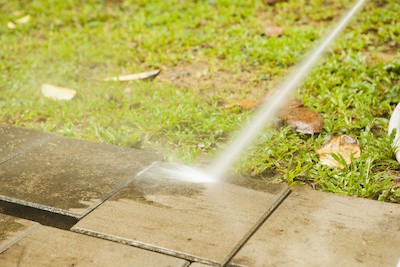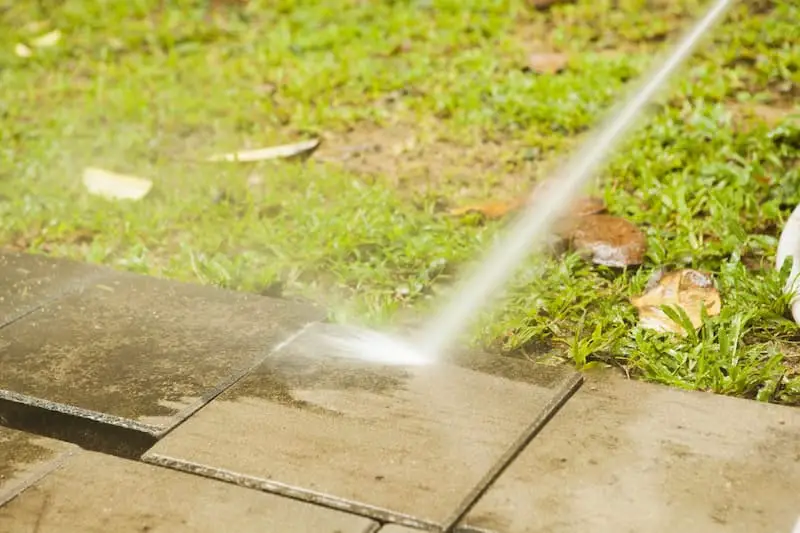Why Your Patio Turns Green
If you’re like me, you enjoy spending lots of time on your patio during the summer. Whether it’s enjoying your coffee in the mornings or having dinner and playing games in the evening – the patio is the center of your house in the summer. Unfortunately, like me, your patio may be susceptible to turning green, which is unsightly and potentially slimy. If you’re wondering why it does this and what you can do to prevent it, keep reading this article!
So, why does my patio turn green? The primary reason why your patio turns green is due to the growth of moss or algae. Moss is a rudimentary plant that thrives in damp, shady areas, while algae are simple organisms that grow in moist environments. Both moss and algae need moisture and sunlight to grow, and they can quickly multiply if the conditions are right.
If your patio is in an area with poor drainage or shaded by trees or structures, it is more susceptible to moss and algae growth. Additionally, if you live in a damp climate or have a lot of rainfall, your patio is more likely to turn green.
Luckily, there are steps you can take to get rid of and prevent the growth of moss or algae on your beautiful patio.

What Exactly Is the “Green Stuff” On My Patio?
Moss, mold, mildew, algae – these are the names of the substances that collect and grow on the surface of your patio. Before you freak out about the word mold – don’t worry, it’s not as dangerous as the stuff that can grow inside your house due to moisture.
Each of these substances thrives in moist environments and their food sources (dust, tree sap, minerals, organic debris, etc.) are in abundant supply on and around your patio. I’m guessing that your patio is surrounded by trees and vegetation that provide great shade but keep your patio more damp than dry.
If your patio were completely dry – you wouldn’t have any growth. Even something as normal and light as morning dew can be enough to sustain the growth. Good news though! There are steps you can take to allow your patio to dry more thoroughly – let’s explore those now.
How Do I Get Rid of the “Green Stuff”?
There are a number of steps you can take to get rid of the mold and mildew on your patio, some that are more involved than others.
- Increase Sun Exposure: Sunlight is our friend. It gives life to our plants and makes the day a little bit better. At the same time, it dries up excess moisture that has collected on your patio, and can even destroy some forms of fungi on contact. Even though you may enjoy your shade, removing some overhanging branches, and making sure sunlight can filter through during the times when you aren’t outside, you will see a quick change in the amount of green on your patio.
- Ensure Proper Runoff: If you have pools of water in certain areas of your patio, you may have a drainage/runoff problem. It could be problems from the construction or over time the pavers or wood planks may have shifted. Either way, it’s important both for the growth of the green substances and for potential structural damage that your patio has a proper way of draining excess moisture.
- Remove Leaves and Debris: Hopefully, you don’t make it a habit of sitting on your patio with tons of leaves and organic debris lying around – but if you do, this could contribute to the growth of mold and algae on your patio. The easy fix is just to remove it! This will help not only with the mold but will also keep gnats and flies from inhabiting your patio.
- Treat with a Copper Solution: Take a note out of the history books – copper was used on the hulls of ships to prevent the growth of barnacles on the wood under the waterline. Today, you can spray a liquid solution of copper on your patio to stop the growth of that pesky green life. Easily available, buy copper sulfate crystals and dissolve them in a warm water solution – then spray on when your patio is nice and dry!
- Power Wash: Probably the solution that takes the longest, power washing is still a good way to get rid of the green stuff on your patio. You’ll want to start on the lowest setting so you don’t damage the wood planks, then gradually increase the setting until you see a clean patio. You should note that once you finish power washing, it would be good to treat the patio with something that will help prevent the grow-back of the green substances – otherwise you’ll be power washing multiple times a year.

How Often Will I Need to Treat My Patio?
Depending on the solution you chose to get rid of the mold and algae, you may need to periodically treat the patio so that the growth doesn’t return. It will also depend on the climate you live in. If the area is very humid – you will probably experience more growth than areas with drier air.
Power washing will be required at least once a year, especially if you don’t treat the patio with another substance. If you choose to use the copper solution, you will need to reapply periodically – higher rainfall will affect this timeline.
If you’re lucky enough to live in an area where you can use the patio year-round, you may have to treat it more often.
Related Questions
Are there places more likely to see green growth on patios than others?
If you live in a humid environment or an area that receives a lot of rainfall over the year, you will likely experience more growth on your patio. Patios in humid areas suck up the excess moisture from the air and hold it in the pores of the wood/concrete pavers.
Areas where you likely don’t need to worry about green growth would be Arizona, Nevada, Wyoming, Montana, and areas of California. On the other hand, areas where you may need to treat your patio often include Florida, Tennessee, Georgia, Louisiana, and South Carolina – basically the southern states.
Is there another substance besides wood or concrete that can be used for a patio?
If you’re getting ready to build your own patio, or maybe you’re looking to improve your existing outdoor living space, there are a few other substances you could use besides wood or concrete pavers. If your patio was damaged by a recent weather event, it may be worthwhile to contact your local insurance company to see if the damage is covered by your homeowner’s policy.
- Gravel – you may think that gravel is a strange option, but really it’s quite easy to maintain and can look very nice if done right. It can be susceptible to green growth without access to sunlight, but for the most part, it’s low maintenance.
- Clay Bricks – when installed correctly, bricks can make your patio look very expensive and beautiful. Though a little bit more expensive, they aren’t as porous as wood and concrete and will not attract as much green growth.
- Flagstone – similar to clay bricks, flagstone is a bit more expensive and you’ll likely want to hire a professional for installation. There are different types of flagstone you can choose from that will do better in your climate – such as not absorbing the moisture in the air.
- Tile – tile is very affordable and you have many different designs and colors to choose from. One downside to tile is how slippery it can get when wet, but it doesn’t actually absorb much moisture.
- Sand – if you want absolutely no green growth, you can always go with a beach vibe and use sand. This likely won’t be an option for many areas, but you can always try it out!
In conclusion, a green patio is a common problem that many homeowners face, but it can be fixed. By understanding the causes of moss and algae growth and taking steps to improve drainage and sunlight exposure, you can keep your patio looking great for years to come. Remember, if you are unsure about how to clean or fix your patio, it is always best to consult a professional to avoid causing any damage.

